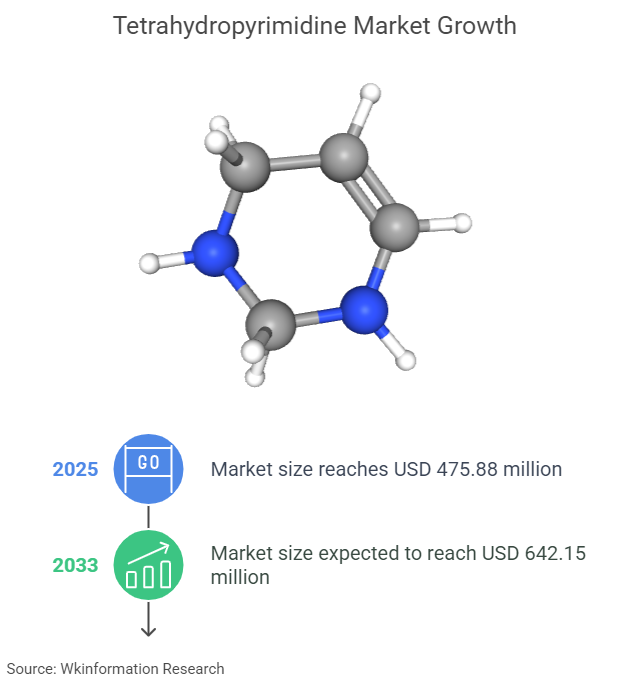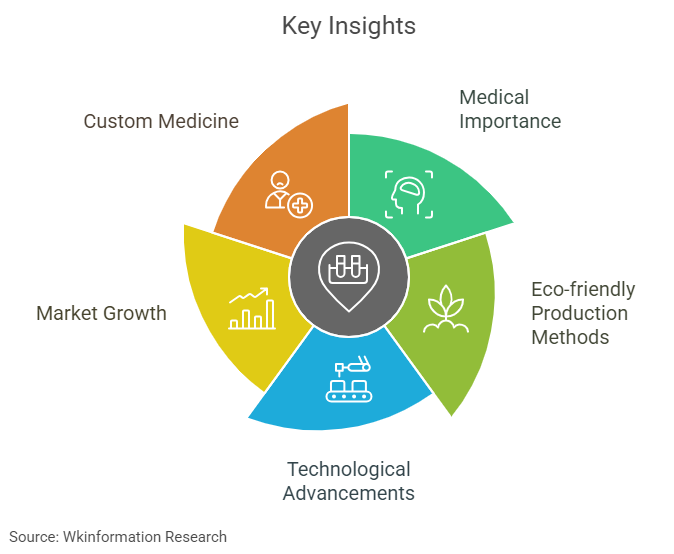
Tetrahydropyrimidine plays a pivotal role in several industries, particularly pharmaceuticals and agrochemicals. Its application in developing anticonvulsants and antidepressants highlights its importance in neurological therapies. In agriculture, tetrahydropyrimidine-based herbicides and fungicides contribute to sustainable crop protection. The tetrahydropyrimidine market benefits from the rising demand for eco-friendly production methods, aligning with global sustainability goals. This compound’s versatility and innovation potential drive its growth, making it indispensable in modern industrial practices. The market size will reach USD 475.88 million in 2025 and is expected to reach USD 642.15 million by 2033, with a CAGR of 3.82% from 2025 to 2033. As industries prioritize green chemistry, tetrahydropyrimidine continues to shape advancements in both health and environmental sectors.
Key Insights
- Tetrahydropyrimidine is important in medicine, especially for treating brain disorders and cancer.
- Eco-friendly methods, like green chemistry, are changing how tetrahydropyrimidine is made.
- New technology, like AI and automation, makes production faster and better.
- The market is growing in Asia-Pacific and Latin America due to higher demand for green agrochemicals and medicines.
- Custom medicine increases the need for tetrahydropyrimidine by creating treatments for specific patients.

Current Trends in the Tetrahydropyrimidine Market

Rising Demand in Biopharma and Pharmaceuticals
The tetrahydropyrimidine market has witnessed significant growth due to its expanding role in biopharma. This compound is essential in developing drugs for neurological disorders, including anticonvulsants and antidepressants. The increasing focus on personalized medicine has further amplified its demand. Tetrahydropyrimidine serves as a versatile intermediate, enabling the creation of tailored treatments that address individual patient needs.
Several biopharma trends have also contributed to this surge. Companies are prioritizing sustainable production methods to comply with stricter environmental regulations. Additionally, collaborations between academic institutions and pharmaceutical firms have accelerated drug discovery and development. These partnerships aim to leverage advanced research methodologies, ensuring the efficient application of tetrahydropyrimidine in novel therapies.
Eco-Friendly and Sustainable Production Processes
Sustainability has become a cornerstone of the tetrahydropyrimidine market. Manufacturers are adopting innovative methods to minimize environmental impact while enhancing production efficiency. Key advancements include:
| Advancement Type | Description | Impact on Production |
|---|---|---|
| Continuous Flow Chemistry | Enhances reaction efficiency by maintaining optimal conditions. | Increases yield by up to 30% compared to batch methods. |
| Automation and Digitalization | Allows precise control over reaction parameters. | Reduces manual oversight and improves consistency. |
| Catalyst Development | Introduction of more active catalysts. | Reduces reaction times by 50% and lowers energy consumption. |
| Green Chemistry Principles | Incorporates solvent-free reactions and renewable resources. | Reduces environmental footprint and waste. |
| Machine Learning and AI | Predicts reaction outcomes and optimizes synthesis routes. | Accelerates discovery of new synthetic routes. |
These advancements align with global sustainability goals, ensuring that tetrahydropyrimidine production remains eco-friendly without compromising quality or efficiency.
Technological Advancements in Synthesis Methods
Technological innovations have revolutionized the synthesis of tetrahydropyrimidine. Continuous flow chemistry has emerged as a game-changer, offering higher yields and better reaction control compared to traditional batch methods. Automation and digitalization have further streamlined processes, reducing human error and ensuring consistent results.
The development of more active catalysts has significantly shortened reaction times, making production faster and more cost-effective. Green chemistry principles, such as solvent-free reactions, have reduced waste and reliance on non-renewable resources. Machine learning has also played a pivotal role, enabling researchers to predict reaction outcomes and optimize synthesis routes efficiently.
These advancements not only enhance the quality of tetrahydropyrimidine but also ensure its sustainable production, meeting the growing demand in biopharma and other industries.
Emerging Applications of Tetrahydropyrimidine
Role in CNS Agents and Neurological Therapies
Tetrahydropyrimidine demonstrates significant potential in neurological therapies. Its derivatives are being explored for their ability to address neurodegenerative diseases. Researchers have identified several promising applications:
- Enhancing cognitive function in patients with memory impairments.
- Modulating neurotransmitter levels to improve brain activity.
- Targeting disorders such as Alzheimer’s and Parkinson’s disease.
These properties make tetrahydropyrimidine a valuable compound in drug discovery and development for central nervous system (CNS) agents. By improving brain health and addressing complex neurological conditions, it contributes to advancing personalized medicine and therapeutic innovation.
Applications in Oncology and Cancer Treatments
The tetrahydropyrimidine market is expanding due to its role in cancer research. Derivatives of this compound are being studied for their anticancer properties, particularly in breast and lung cancer models. These compounds inhibit cancer cell proliferation and induce apoptosis, a process that eliminates damaged or abnormal cells.
The mechanism involves the modulation of critical signaling pathways, such as the PI3K/Akt/mTOR pathway, which is essential for cancer cell survival and growth. This targeted approach enhances the effectiveness of treatments while minimizing harm to healthy cells. As research progresses, tetrahydropyrimidine continues to emerge as a cornerstone in the fight against cancer.
Innovations in Drug Delivery Systems
Tetrahydropyrimidine plays a pivotal role in modern drug delivery systems. Its ability to form stable complexes with biomolecules enhances the bioavailability of drugs with poor solubility. This innovation improves therapeutic outcomes by ensuring that medications are absorbed efficiently in the body.
Patients benefit from reduced side effects and safer treatments, as these systems deliver drugs more precisely to their intended targets. The integration of tetrahydropyrimidine into advanced delivery platforms highlights its importance in optimizing pharmaceutical formulations and improving patient care.
Regulatory and Environmental Factors Shaping the Market
Global Regulatory Frameworks and Compliance
The tetrahydropyrimidine market operates under stringent global regulatory frameworks. These regulations ensure safety, environmental protection, and adherence to pharmaceutical standards. In the European Union, the REACH regulation mandates the registration, evaluation, and authorization of chemicals, influencing production timelines and costs. Similarly, the United States enforces the TSCA, which governs the manufacturing and distribution of chemical substances. For pharmaceutical applications, the FDA requires rigorous testing and approval processes before drug formulations can enter the market.
These frameworks create a complex environment for manufacturers. Companies must navigate compliance requirements while maintaining efficiency in production. Non-compliance can lead to significant delays, increased costs, and potential market restrictions. By adhering to these regulations, producers ensure that tetrahydropyrimidine meets the highest safety and quality standards, fostering trust among consumers and stakeholders.
Green Chemistry and Sustainability Initiatives
Sustainability initiatives are reshaping the tetrahydropyrimidine market. Producers are adopting green chemistry practices to minimize environmental impact and align with global sustainability goals. These efforts include:
- Developing synthetic pathways that reduce waste and carbon emissions.
- Incorporating tetrahydropyrimidine into eco-friendly agrochemical formulations for sustainable agriculture.
- Investing in cleaner technologies to comply with stringent environmental regulations.
The agricultural sector exemplifies this shift by integrating tetrahydropyrimidine into formulations that protect crops without harming the environment. Additionally, companies are modifying production methods to reduce reliance on non-renewable resources. These initiatives not only enhance the market’s environmental profile but also position tetrahydropyrimidine as a key player in sustainable industrial practices.
By prioritizing compliance and sustainability, the tetrahydropyrimidine market continues to evolve. These efforts ensure that the compound remains relevant in a world increasingly focused on environmental responsibility and regulatory adherence.
Technological Innovations Driving the Tetrahydropyrimidine Market

Automation in Manufacturing Processes
Automation has transformed the production of tetrahydropyrimidine, enhancing efficiency and sustainability. Continuous flow chemistry has emerged as a key innovation, improving reaction efficiency and increasing yields by up to 30% compared to traditional batch methods. Automated reactors equipped with real-time monitoring systems ensure precise control over reaction parameters, reducing the need for manual oversight. These systems not only improve consistency but also minimize errors during production.
The introduction of advanced catalysts, such as nanostructured variants, has further optimized manufacturing processes. These catalysts significantly reduce reaction times—by as much as 50%—while improving selectivity. This advancement aligns with green chemistry principles, making production more environmentally friendly. Additionally, solvent-free reactions and microwave-assisted synthesis have reduced both environmental impact and synthesis time. Automation continues to play a pivotal role in ensuring the tetrahydropyrimidine market meets growing global demand efficiently.
Integration of AI in Biopharma Research
Artificial intelligence (AI) has revolutionized biopharma research, particularly in the development of tetrahydropyrimidine-based compounds. AI-driven algorithms analyze vast datasets to identify potential applications for tetrahydropyrimidine in drug discovery. These tools predict reaction outcomes and optimize synthesis routes, accelerating the development of new pharmaceutical formulations.
In biopharma, AI enhances the precision of personalized medicine by identifying patient-specific therapeutic needs. This technology enables researchers to tailor tetrahydropyrimidine derivatives for targeted treatments, such as neurological therapies and oncology drugs. By integrating AI, biopharma companies can streamline research processes, reduce costs, and bring innovative treatments to market faster.
Advancements in Green Chemistry Techniques
Green chemistry techniques have become integral to the sustainable production of tetrahydropyrimidine. Researchers have adopted eco-friendly methods, such as solvent-free reactions, to minimize waste and reliance on non-renewable resources. Microwave-assisted synthesis has emerged as a game-changer, significantly reducing reaction times and energy consumption.
The use of renewable feedstocks and biodegradable solvents further enhances the environmental profile of tetrahydropyrimidine production. These advancements align with global sustainability goals, ensuring that the compound remains a key player in eco-friendly industrial practices. By prioritizing green chemistry, manufacturers contribute to a more sustainable future while maintaining high-quality production standards.
Product Segmentation Analysis in the Tetrahydropyrimidine Market
By Type: Powder and Solution
The tetrahydropyrimidine market offers two primary product types: powder and solution. Each form caters to specific industrial and pharmaceutical needs, ensuring versatility in its applications. The powder form is widely used due to its stability and ease of storage. It serves as a critical intermediate in chemical synthesis, particularly in the production of pharmaceuticals and agrochemicals. Its solid-state nature allows for precise measurements, making it ideal for controlled reactions in laboratory and industrial settings.
The solution form, on the other hand, provides enhanced solubility and ease of application. This form is particularly advantageous in processes requiring immediate reactivity or liquid-phase reactions. In pharmaceutical formulations, the solution form ensures better bioavailability, improving the efficacy of drugs. Both forms of tetrahydropyrimidine contribute significantly to its widespread adoption across industries, highlighting its adaptability and importance in modern applications.
By Application: Personal Care and Hospital Use
Tetrahydropyrimidine finds extensive use in personal care and hospital settings, demonstrating its versatility and value. In personal care, it is incorporated into formulations for skincare and haircare products. Its derivatives enhance the stability and effectiveness of active ingredients, ensuring better performance in cosmetic applications. The compound’s ability to improve product shelf life and maintain efficacy under various conditions makes it a preferred choice for manufacturers.
In hospital use, tetrahydropyrimidine plays a crucial role in pharmaceutical formulations. It is utilized in the development of drugs for neurological disorders, cancer treatments, and advanced drug delivery systems. Its ability to form stable complexes with biomolecules enhances the therapeutic potential of medications, ensuring better patient outcomes.
This segmentation underscores the compound’s adaptability, catering to diverse needs in both personal care and healthcare industries. Its dual availability as powder and solution ensures that manufacturers can tailor its use to specific requirements, further solidifying its position in the global market.
Market Dynamics and Challenges
Supply Chain Challenges in the Tetrahydropyrimidine Market
The tetrahydropyrimidine market faces several supply chain challenges that impact revenue and operational efficiency. Key issues include:
- Sourcing raw materials is complicated by availability constraints and price fluctuations, creating bottlenecks in production.
- Transportation logistics are hindered by compliance with regulatory frameworks, leading to delays.
- The global pandemic exposed vulnerabilities, prompting companies to reassess supply chain strategies.
- Sustainability concerns require manufacturers to adopt greener practices and reevaluate sourcing strategies.
- Collaboration within the industry is essential to address these challenges through strategic partnerships.
These challenges highlight the need for robust strategies to ensure the smooth flow of materials and maintain market stability.
Solutions to Overcome Supply Chain Issues
To address these challenges, companies in the tetrahydropyrimidine market are implementing innovative solutions. These include:
- Seeking alternative suppliers to mitigate risks associated with raw material volatility.
- Adopting technology-driven solutions, such as real-time tracking systems, to enhance logistics operations.
- Exploring vertical integration to gain greater control over supply chains and reduce dependency on external suppliers.
- Investing in sustainable technologies and bio-based feedstocks to comply with environmental regulations.
- Fostering industry collaboration through strategic partnerships to drive innovation and improve efficiency.
These measures not only stabilize supply chains but also align with sustainability goals, ensuring long-term growth and revenue generation.
Pricing Trends and Competitive Pressures
The tetrahydropyrimidine market is experiencing intense competitive pressures from multinational corporations and emerging local players. Local entities leverage their understanding of regional dynamics to tailor products, enhancing market penetration. Technological advancements, particularly in green chemistry, have made production more efficient and sustainable, meeting the rising demand for eco-friendly products. Companies are forming strategic collaborations to combine strengths in technology and distribution, intensifying competition further.
Geographic expansion into emerging economies, especially in Asia-Pacific, is another trend as companies capitalize on increasing healthcare investments. These strategies not only boost revenue but also position companies to navigate competitive pressures effectively. The market dynamics continue to evolve, driven by innovation and strategic investments.
Regional Growth Opportunities in the Tetrahydropyrimidine Market
Untapped Potential in Asia-Pacific
The Asia-Pacific region presents significant growth opportunities for the tetrahydropyrimidine market. Emerging economies like India are driving demand for tetrahydropyrimidine derivatives, particularly in the pharmaceutical sector. The compound plays a crucial role in synthesizing antiviral and anticancer agents, aligning with the region’s growing focus on biopharmaceuticals.
Several factors contribute to this untapped potential:
- The agricultural sector is adopting sustainable practices, incorporating tetrahydropyrimidine into eco-friendly agrochemical formulations.
- Evolving regulatory frameworks, especially in India, incentivize foreign investment and enhance local production capabilities.
- Rising healthcare investments and advancements in biotechnology are fueling demand for cost-effective synthesis routes.
These trends position Asia-Pacific as a key region for market expansion, offering opportunities for both local and international players.
Growth Opportunities in Latin America
Latin America is emerging as a promising market for tetrahydropyrimidine, driven by increasing demand in pharmaceuticals and agrochemicals. Government initiatives supporting market growth and the rise of local players with regional insights are shaping the competitive landscape.
Key growth drivers include:
- The incorporation of tetrahydropyrimidine in agrochemical formulations, particularly as pesticides and herbicides.
- Alignment with global trends for environmentally friendly agricultural practices.
- The compound’s role in synthesizing antiviral and anticancer agents, meeting the region’s healthcare needs.
Local entities are tailoring products to meet specific consumer demands, enhancing market penetration. These developments, combined with a focus on cost-effective synthesis routes, make Latin America a strategic region for market growth.
Established Markets in North America and Europe
North America and Europe represent mature markets for tetrahydropyrimidine, characterized by a dynamic competitive landscape and strong regulatory frameworks. Local players leverage their understanding of regional dynamics to tailor products, enhancing customer loyalty and market penetration.
Key characteristics of these markets include:
- A strong emphasis on technological advancements, including green chemistry techniques, to improve production efficiency and sustainability.
- Regulatory frameworks like REACH in the EU and TSCA in the US, which ensure safety and environmental protection but increase operational costs.
- Significant opportunities in both the pharmaceutical and agricultural sectors, driven by sustainability initiatives and government incentives.
These regions continue to lead in innovation, setting benchmarks for quality and compliance in the tetrahydropyrimidine market.
Competitive Landscape of the Tetrahydropyrimidine Market
Key Player
- bitop AG
- VIO Chemicals AG
- Shenzhen Siyomicro Bio-Tech
- Bloomage Biotechnology
- PhaBuilder
- Shandong Freda Biotech
- AnHui HaiKang Pharmaceutical
Strategies Adopted by Key Players
Key players in the tetrahydropyrimidine market employ diverse strategies to maintain their competitive edge. Innovation through research and development remains a cornerstone. Companies focus on expanding product lines by introducing new derivatives tailored for pharmaceutical applications. Geographic expansion into emerging economies, such as Asia-Pacific and Latin America, allows firms to tap into rising demand for tetrahydropyrimidine-based products.
Sustainability has become a focal point for many manufacturers. As regulatory pressures increase and consumer preferences shift toward environmentally friendly products, companies are investing in green chemistry practices. These efforts align with global sustainability goals and enhance brand reputation. Strategic collaborations also play a vital role. Partnerships enable firms to leverage strengths in technology, distribution, and market access, ensuring a broader reach and improved operational efficiency.
Pricing strategies further contribute to competitiveness. By optimizing production costs through advancements like continuous flow chemistry, companies can offer cost-effective solutions without compromising quality. These combined efforts position key players to thrive in a dynamic and evolving market.
Collaborations and Partnerships in the Industry
Collaborations and partnerships significantly shape the tetrahydropyrimidine industry. Strategic alliances between chemical manufacturers and biotech firms merge synthetic chemistry expertise with biopharma development capabilities. These partnerships accelerate the creation of innovative pharmaceutical formulations, enhancing the compound’s application in neurological and oncology therapies.
Academic institutions also play a crucial role. Collaborations with industry players facilitate knowledge exchange and the translation of research into commercial applications. For instance, joint ventures focusing on green chemistry techniques have led to more sustainable production methods. Such partnerships not only drive innovation but also strengthen the industry’s ability to meet regulatory and environmental standards.
Innovations Driving Competitive Advantage
Technological advancements provide a substantial competitive advantage in the tetrahydropyrimidine market. Continuous flow chemistry enhances reaction efficiency, reducing production costs and increasing yields by up to 30%. Automation and digitalization ensure precise control over reaction parameters, improving consistency and minimizing errors.
Catalyst development has introduced advanced variants that reduce reaction times by 50% while improving selectivity. These innovations align with green chemistry principles, incorporating solvent-free reactions and renewable resources to minimize environmental impact. Machine learning and AI further optimize synthesis routes, accelerating the discovery of new applications for tetrahydropyrimidine in biopharma and other industries.
| Innovation Type | Description | Impact on Competitive Advantage |
|---|---|---|
| Continuous Flow Chemistry | Enhances reaction efficiency and reduces reaction times, increasing yields by up to 30%. | Higher production efficiency and reduced costs. |
| Automation and Digitalization | Provides precise control over reaction parameters, ensuring consistency and reproducibility. | Reduces manual oversight and optimizes processes. |
| Catalyst Development | Introduction of advanced catalysts that can reduce reaction times by 50% and improve selectivity. | Faster synthesis and environmentally friendly. |
| Green Chemistry Principles | Incorporation of solvent-free reactions and renewable resources, reducing environmental footprint. | Aligns with sustainability goals and reduces waste. |
| Machine Learning and AI | Predicts reaction outcomes and optimizes synthesis routes, enhancing efficiency in development. | Accelerates discovery and improves production methods. |
These innovations ensure that manufacturers remain competitive while meeting the growing demand for sustainable and high-quality tetrahydropyrimidine products.
Future Projections for the Tetrahydropyrimidine Market
Market Growth Forecasts for 2025 and Beyond
The tetrahydropyrimidine market is poised for substantial growth in the coming years. This expansion stems from the compound’s increasing applications in pharmaceuticals and agrochemicals. Advancements in synthetic methodologies further contribute to this upward trajectory. The pharmaceutical sector, in particular, continues to drive demand as tetrahydropyrimidine plays a critical role in developing innovative treatments for neurological disorders and cancer.
The agrochemical industry also bolsters market growth by integrating tetrahydropyrimidine into sustainable formulations. These eco-friendly solutions align with global trends advocating for environmentally responsible practices. As industries prioritize green chemistry and technological innovation, the market’s long-term growth potential remains robust.
Impact of Personalized Medicine on Market Demand
Personalized medicine significantly influences the demand for tetrahydropyrimidine. This approach tailors treatments to individual patient needs, requiring versatile intermediates like tetrahydropyrimidine. Key factors driving this demand include:
- The compound’s adaptability for specific therapeutic targets in personalized treatments.
- Its diverse chemical properties, which enhance its suitability for customized drug delivery systems.
- The growing focus on precision medicine, which relies on compounds that enable targeted and effective therapies.
These attributes position tetrahydropyrimidine as an essential component in the evolving landscape of personalized healthcare.
Long-Term Trends in Sustainability and Innovation
Sustainability and innovation will shape the future of the tetrahydropyrimidine market. Several trends highlight this trajectory:
- The adoption of eco-friendly production processes, reducing waste and carbon emissions.
- Advancements in synthetic methodologies, including high-throughput screening and computational chemistry, which accelerate the discovery of new derivatives.
- Increased integration of tetrahydropyrimidine into pharmaceutical and agricultural applications, driven by global advocacy for sustainable practices.
- Collaboration between academia and industry, fostering innovation and enhancing production efficiency.
The agricultural sector exemplifies these trends by incorporating tetrahydropyrimidine into formulations that support environmentally friendly farming. These developments, coupled with the rise of personalized medicine, ensure the market’s relevance and adaptability in the long term.
Overview
The tetrahydropyrimidine market continues to evolve, driven by several key trends and growth factors. Increasing demand for pharmaceutical applications, particularly in neurological therapies, highlights its critical role in modern medicine. The rise of personalized medicine and the expansion of agrochemical applications further underscore its versatility. Sustainable production processes, supported by advancements in green chemistry, align with tightening environmental regulations and global sustainability goals.
Technological innovations, such as continuous flow chemistry and AI-driven synthesis optimization, are reshaping production efficiency and enabling the discovery of new applications. As industries prioritize eco-friendly practices and regulatory compliance, tetrahydropyrimidine remains at the forefront of innovation and expansion. Its adaptability ensures it will continue to meet the evolving needs of pharmaceuticals and agriculture, solidifying its role in a sustainability-driven future.
| Report Metric | Details |
|---|---|
| Report Name | Global Tetrahydropyrimidine Market Report |
| Base Year | 2024 |
| Segment by Type | · Powder
· Solution |
| Segment by Application | · Personal Care
· Hospital Use |
| Geographies Covered | · North America (United States, Canada)
· Europe (Germany, France, UK, Italy, Russia) · Asia-Pacific (China, Japan, South Korea, Taiwan) · Southeast Asia (India) · Latin America (Mexico, Brazil) |
| Forecast units | USD million in value |
| Report coverage | Revenue and volume forecast, company share, competitive landscape, growth factors and trends |
FAQ
What is tetrahydropyrimidine, and why is it important?
Tetrahydropyrimidine is a versatile chemical compound widely used in pharmaceuticals and agrochemicals. Its importance lies in its role as an intermediate in drug synthesis, particularly for neurological and cancer therapies, and as a component in eco-friendly agricultural formulations.
How does tetrahydropyrimidine contribute to sustainability?
Tetrahydropyrimidine production incorporates green chemistry principles, such as solvent-free reactions and renewable feedstocks. These methods reduce waste and carbon emissions, aligning with global sustainability goals. Its use in eco-friendly agrochemicals further supports environmentally responsible practices.
Which industries benefit most from tetrahydropyrimidine?
The pharmaceutical and agricultural industries benefit significantly. In pharmaceuticals, it aids in developing treatments for neurological disorders and cancer. In agriculture, it enhances crop protection through sustainable herbicides and fungicides, supporting environmentally friendly farming practices.
What are the challenges in the tetrahydropyrimidine market?
The market faces challenges like raw material shortages, regulatory compliance, and supply chain disruptions. Manufacturers address these issues by adopting sustainable technologies, exploring alternative suppliers, and leveraging automation to streamline production processes.
What is the future outlook for the tetrahydropyrimidine market?
The market size will reach USD 475.88 million in 2025 and is expected to reach USD 642.15 million by 2033, with a CAGR of 3.82% from 2025 to 2033. Increasing demand in pharmaceuticals, advancements in green chemistry, and the rise of personalized medicine drive this growth. Its adaptability ensures continued relevance in sustainable industrial practices.
Global Tetrahydropyrimidine Market Report – Table of Contents
1 Market Study Overview
2 Basic Product Information
3 Market Analysis
4 Tetrahydropyrimidine Related Market Analysis
5 Global Trend Summary
6 Competition by Manufacturer
7 Analysis of Key Players
8 Global Tetrahydropyrimidine Revenue, Sales Categorized by Regions
9 North America Tetrahydropyrimidine Market Size Categorized by Countries
10 Europe Tetrahydropyrimidine Market Size Categorized by Countries
11 Asia-pacific Tetrahydropyrimidine Market Size Categorized by Countries
12 South America Tetrahydropyrimidine Market Size Categorized by Countries
13 Middle East and Africa Tetrahydropyrimidine Market Size Categorized by Countries
14 Global Tetrahydropyrimidine Industry Segment Analysis
15 Global Tetrahydropyrimidine Market Forecast
16 Research Findings and Conclusion
17 Appendix


